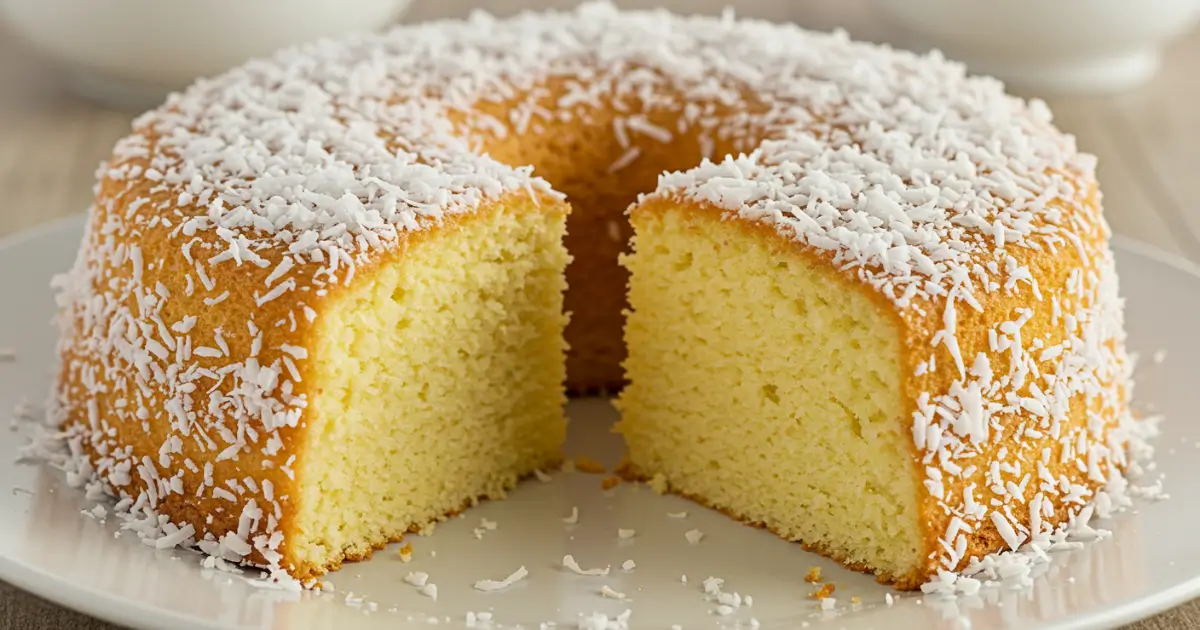Coconut cake is more than just a dessert—it’s a treat that feels like a vacation in every bite. With its soft, moist texture and sweet, tropical flavor, this cake brings people together and makes any occasion special whether you’re celebrating a birthday, or holiday, or just because, coconut cake always impresses.
Why We Love This Coconut Cake
Coconut cake has long been a beloved dessert, and for good reason. It’s not just about the flavor; it’s about the whole experience of enjoying it. Here’s why coconut cake should be your next baking project:
- Tropical Flavor: Coconut has a unique ability to transport you to a tropical paradise, even when you’re just sitting at your kitchen table. Its rich, nutty flavor infuses the cake layers, making every bite a delightful experience.
- Moist and Flavorful: One of the hallmarks of a great coconut cake is its moist texture. When baked correctly, this cake is incredibly soft and moist, ensuring that each forkful is as delicious as the first.
- Versatile for Occasions: From birthdays to holiday gatherings, coconut cake fits any celebration. It’s the perfect dessert for when you want to add a little touch of elegance and sweetness to your event.
- A Feast for the Eyes: There’s no denying the visual appeal of coconut cake. With its snowy white layers covered in shredded coconut, it’s a showstopper on any dessert table.

Ingredients
Now that you know why coconut cake is so irresistible, let’s get into the ingredients you’ll need to make it from scratch. For this recipe, we’ll focus on the basics to ensure the cake comes out just right.
Cake flour – Essential for achieving a tender texture and fine crumb. Avoid substituting with all-purpose flour, as it will lead to a coarser texture.
Leavening – Baking powder is needed for proper rise and texture. Do not substitute with baking soda as they are not interchangeable.
Unsalted butter – Adds flavor and moisture to the cake. If necessary, substitute with salted butter, but reduce the listed salt by half.
Granulated sugar – Provides sweetness and contributes to the cake’s light texture.
Eggs – Essential for binding and providing structure, moisture, and richness.
Full-fat coconut milk – Adds a creamy texture and rich coconut flavor to the cake.
Vanilla extract – Enhances the overall flavor profile of the coconut cake.
Shredded coconut – Adds texture and coconut flavor to the cake. It is also used for coating the top of the cake to give it a visually appealing look and extra coconut taste.
How to Make Coconut Cake
Making coconut cake is a straightforward process, but following the steps carefully ensures that you get the perfect texture and flavor. Here’s how to do it:
Prepare the Oven and Cake Pans:
Preheat your oven to 350°F (175°C). Grease and flour two 9-inch round cake pans. This will prevent the cake from sticking and make it easier to remove once it’s baked.
Mix the Dry Ingredients:
In a medium bowl, combine the all-purpose flour, baking powder, baking soda, and a pinch of salt. Whisk them together to ensure everything is evenly distributed. This step is crucial for ensuring your cake rises perfectly.
Cream the Butter and Sugar:
In a large bowl, beat the unsalted butter and granulated sugar together using an electric mixer. Beat on medium speed until the mixture becomes light and fluffy. This will take about 3-4 minutes. This step helps create a lighter texture in the cake.
Add the Eggs and Coconut Milk:
Beat in the eggs one at a time, ensuring that each egg is fully incorporated before adding the next. Then, add the coconut milk and vanilla extract, mixing well. Coconut milk adds moisture and a richer flavor to the cake.
Combine the Wet and Dry Ingredients:
Gradually add the dry ingredients to the wet mixture, mixing just until everything is combined. Be careful not to overmix, as that can lead to a dense cake. Fold in the shredded coconut for that signature coconut flavor.
Bake the Cake:
Divide the batter evenly between the two prepared cake pans. Bake for 25-30 minutes, or until a toothpick inserted into the center comes out clean. Every oven is different, so keep an eye on the cake during the last few minutes of baking.
Cool and Frost:
Allow the cakes to cool in the pans for 10 minutes before transferring them to a wire rack. Once completely cooled, frost the cake with your coconut frosting. Don’t forget to frost the sides and top, and generously coat the cake with more shredded coconut.
Expert Tips for Perfect Coconut Cake
To ensure your coconut cake turns out perfectly every time, follow these expert tips:
Use Room Temperature Ingredients: Always make sure your butter and eggs are at room temperature before starting. Room-temperature ingredients mix better and help create a smoother batter, leading to a fluffier cake.
Measure Your Flour Correctly: Too much flour can make your cake dry. When measuring flour, spoon it into the measuring cup and level it off with a knife for the most accurate measurement.
Don’t Overmix: While mixing your batter, stop as soon as the ingredients are combined. Overmixing can lead to a dense, tough cake.
Test for Doneness Early: Ovens vary, so it’s important to test the cake for doneness 5 minutes before the recommended baking time ends. Insert a toothpick into the center; it should come out clean or with just a few crumbs.
Variations of Coconut Cake
Once you’ve mastered the classic coconut cake, there are plenty of ways to mix things up and add your own twist. Here are a few variations:
Lemon Coconut Cake: For a citrusy twist, add the zest and juice of one lemon to the batter. This will brighten up the coconut flavor and give your cake a refreshing kick.
Chocolate Coconut Cake: If you love the combination of chocolate and coconut, simply add ¼ cup of cocoa powder to the dry ingredients. You can even add chocolate chips to the batter for an extra layer of flavor.
Coconut Cream Cake: Replace the coconut milk with coconut cream for a richer, creamier texture. This will make your cake even more decadent.
Pineapple Coconut Cake: Add crushed pineapple to the batter for a tropical twist. The pineapple adds moisture and a subtle sweetness that pairs perfectly with the coconut.
Serving Your Coconut Cake
Coconut cake isn’t just a treat for the taste buds—it’s also a visual delight. Here are a few ideas to help you serve your coconut cake in style:
Pair with Tropical Fruit: Serve your coconut cake with a side of fresh tropical fruits like pineapple, mango, or papaya. The sweetness and acidity of the fruits complement the rich cake perfectly.
Coffee Pairing: For an elevated dessert experience, serve your coconut cake with a cup of coffee or a rich iced latte. The bitterness of the coffee balances the sweetness of the cake.
Elegant Garnishes: Top your cake with edible flowers like orchids or pansies to add a touch of elegance. You can also add a dusting of powdered sugar or serve with whipped cream for a decadent finishing touch.
Frequently Asked Questions About Coconut Cake
Q1: Can I make coconut cake ahead of time?
Absolutely! You can bake the cake layers a day in advance. Just store them in an airtight container at room temperature. Frost the cake just before serving to keep it fresh.
Q2: Why is my coconut cake dry?
Dry coconut cake is often the result of overbaking or using too much flour. Make sure to measure the flour correctly and check the cake early to avoid overbaking.
Q3: Can I use shredded coconut from the store for the topping?
Yes, store-bought shredded coconut works just fine for the topping. However, to get an extra burst of coconut flavor, you can toast the coconut lightly before using it.
Q4: How should I store leftover coconut cake?
Store leftovers in an airtight container at room temperature for up to 3 days. If you want to keep it for longer, refrigerate the cake for up to a week.
Q5: Can I make coconut cake gluten-free?
Yes, you can substitute the all-purpose flour with a gluten-free flour blend to make the cake gluten-free. Just ensure you use a blend designed for baking to achieve the best results.

Coconut Cake
Equipment
- Cake Pans
- Electric Mixer
Ingredients
- Cake Flour
- 2 cups Granulated Sugar
- 1 cup Unsalted Butter room temperature
- 4 large Eggs
- 1 cup Full-fat Coconut Milk
- 1 teaspoon Vanilla Extract
- 1 cup Shredded Coconut unsweetened
Instructions
- Preheat the oven to 350°F (175°C). Grease and flour two 9-inch round cake pans.
- In a medium bowl, combine the cake flour, baking powder, and salt. Set aside.
- In a large bowl, cream the butter and granulated sugar together until light and fluffy, about 3-4 minutes.
- Add the eggs one at a time, beating well after each addition. Mix in the coconut milk and vanilla extract.
- Gradually add the dry ingredients to the wet ingredients, mixing until just combined. Fold in the shredded coconut.
- Divide the batter evenly between the prepared cake pans and bake for 25-30 minutes, or until a toothpick comes out clean.
- Let the cakes cool in the pans for 10 minutes, then transfer to a wire rack to cool completely.
- Frost with coconut frosting and coat the top and sides with more shredded coconut.
Send me this recipe!
Just enter your email below and get it sent straight to your inbox!



